BUSN20019 Project: Royalty Expenses Impact on OZ Minerals Revenue
VerifiedAdded on 2023/04/19
|13
|2799
|425
Project
AI Summary
This project proposal investigates the impact of royalty expenses on the revenue of OZ Minerals. It begins by defining revenue and royalty expenses, highlighting their importance in business operations. The literature review explores the causes of royalty expenses, such as accessing technological advancements and expanding product reach, and their potential advantages, including ownership of resources without operational responsibility. The methodology outlines the use of secondary data collection, involving both qualitative and quantitative analysis of internal and external sources. A Gantt chart provides a timeline for the project's completion. The research aims to determine the extent to which changes in royalty expenses affect OZ Minerals' revenue, considering both the potential benefits and drawbacks of royalty agreements. This document is available on Desklib, a platform offering a range of study tools and solved assignments for students.
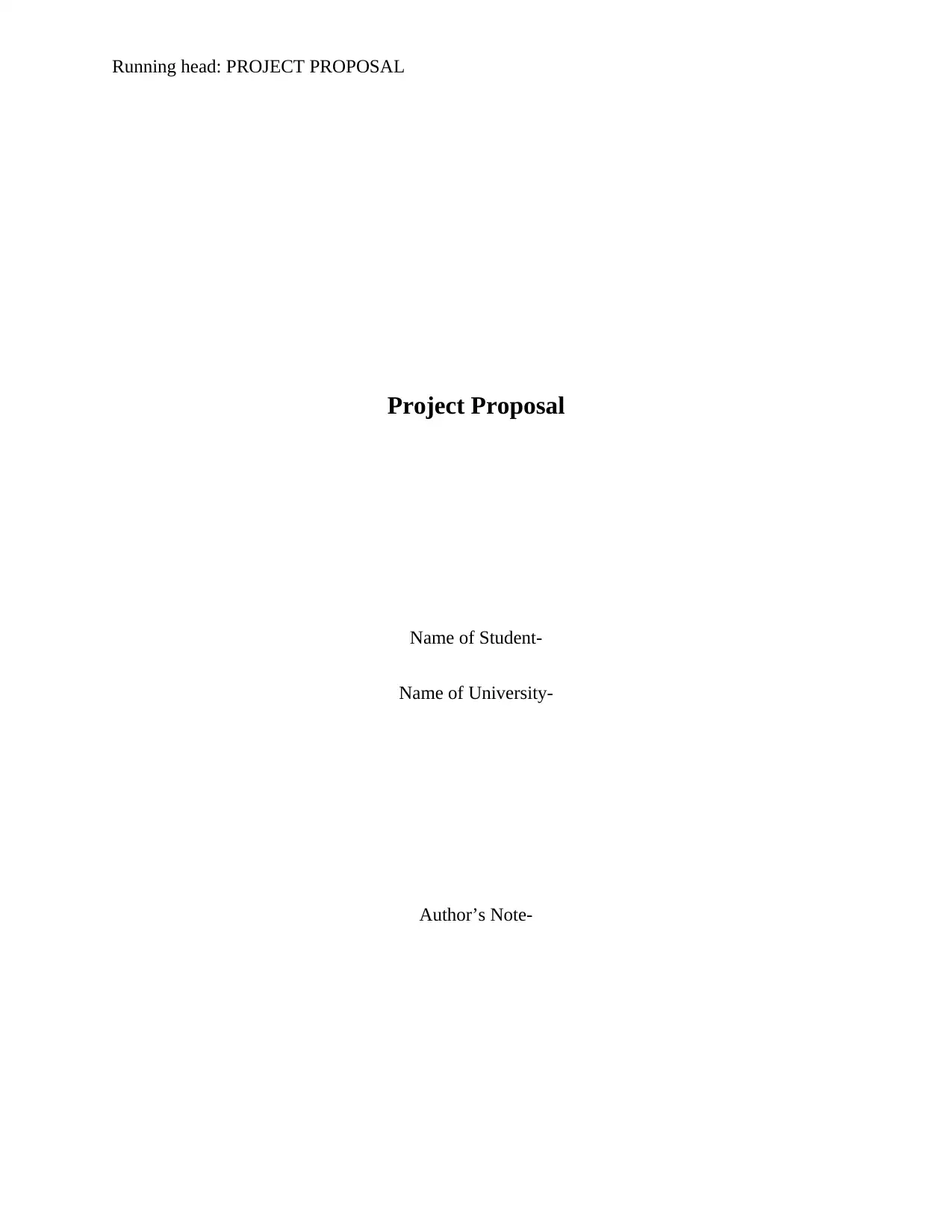
Running head: PROJECT PROPOSAL
Project Proposal
Name of Student-
Name of University-
Author’s Note-
Project Proposal
Name of Student-
Name of University-
Author’s Note-
Paraphrase This Document
Need a fresh take? Get an instant paraphrase of this document with our AI Paraphraser
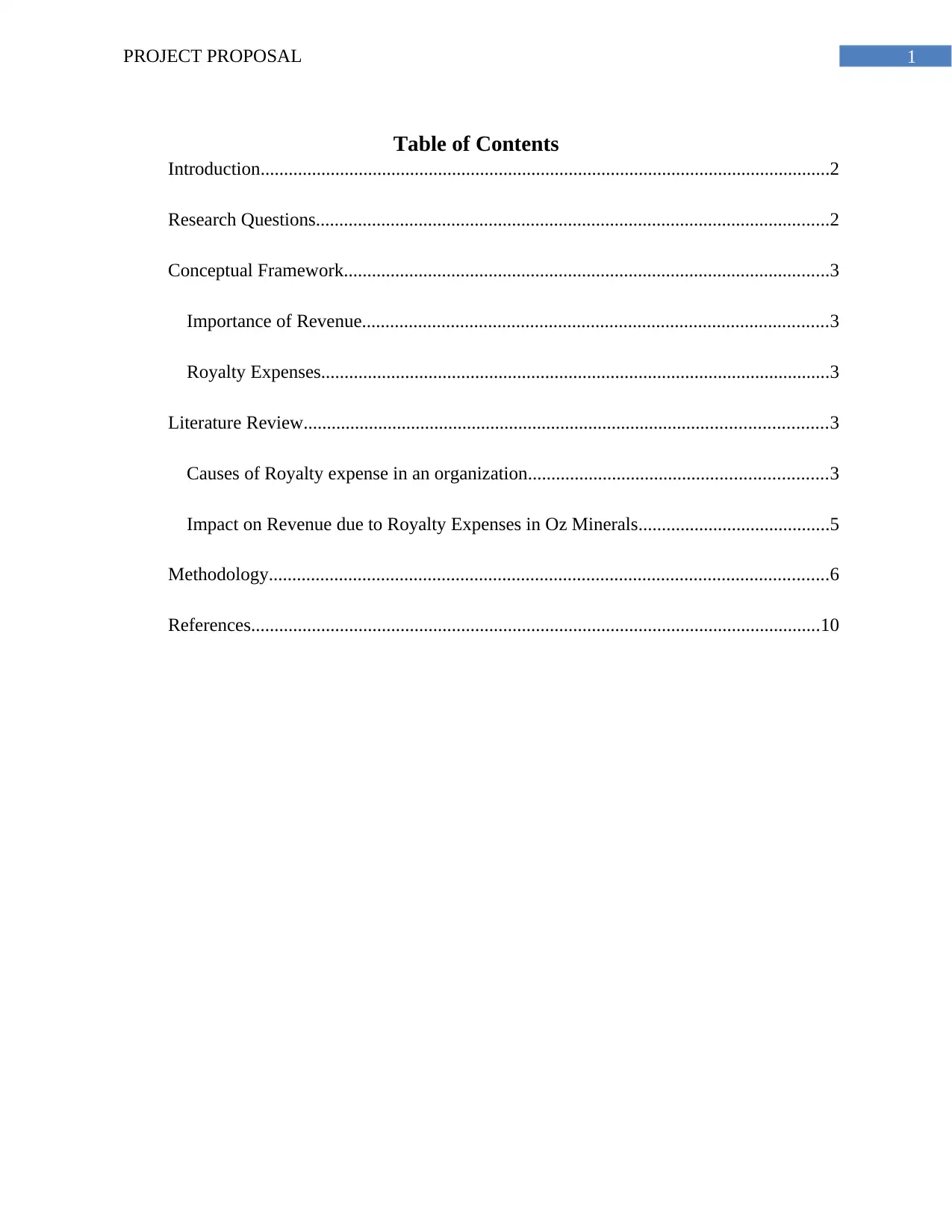
1PROJECT PROPOSAL
Table of Contents
Introduction..........................................................................................................................2
Research Questions..............................................................................................................2
Conceptual Framework........................................................................................................3
Importance of Revenue....................................................................................................3
Royalty Expenses.............................................................................................................3
Literature Review................................................................................................................3
Causes of Royalty expense in an organization................................................................3
Impact on Revenue due to Royalty Expenses in Oz Minerals.........................................5
Methodology........................................................................................................................6
References..........................................................................................................................10
Table of Contents
Introduction..........................................................................................................................2
Research Questions..............................................................................................................2
Conceptual Framework........................................................................................................3
Importance of Revenue....................................................................................................3
Royalty Expenses.............................................................................................................3
Literature Review................................................................................................................3
Causes of Royalty expense in an organization................................................................3
Impact on Revenue due to Royalty Expenses in Oz Minerals.........................................5
Methodology........................................................................................................................6
References..........................................................................................................................10
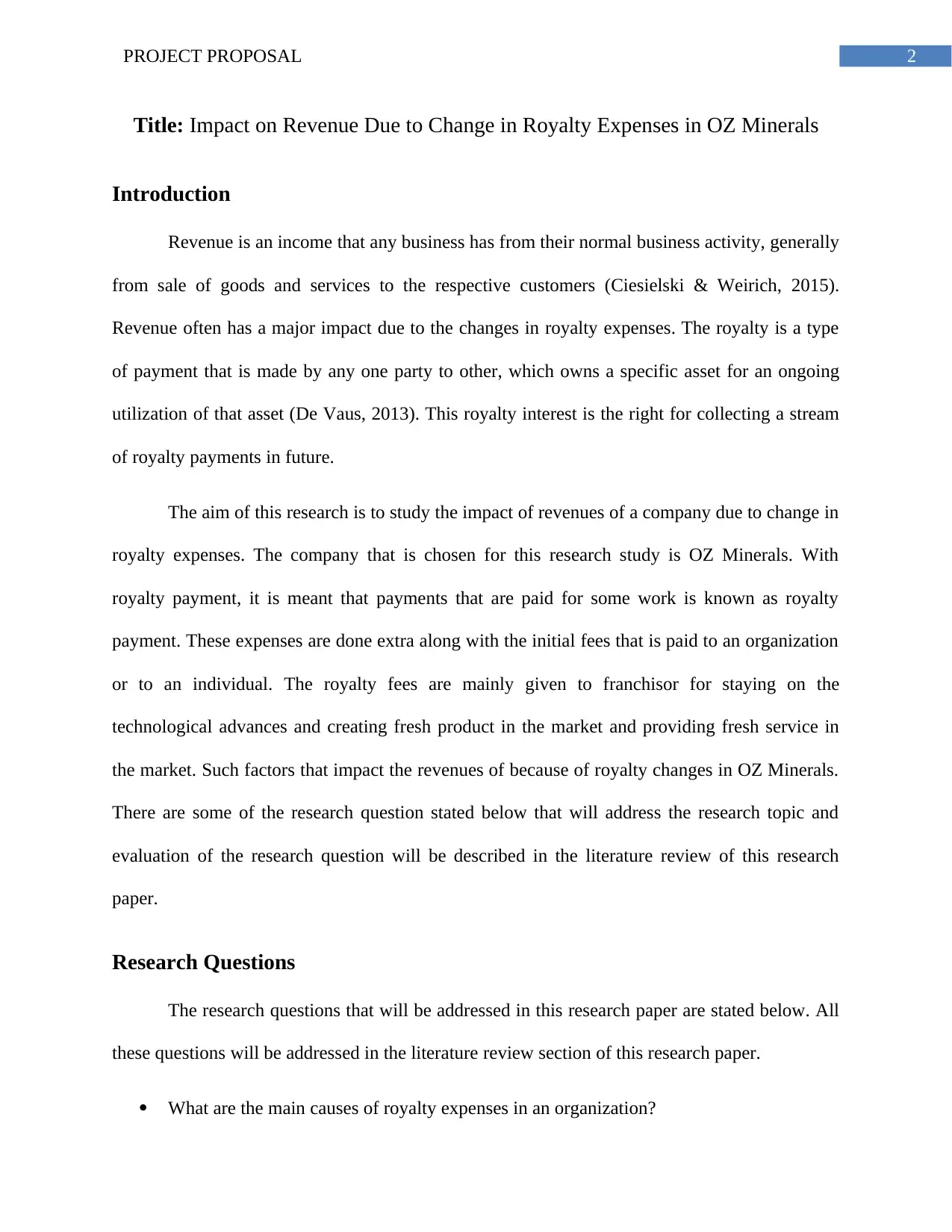
2PROJECT PROPOSAL
Title: Impact on Revenue Due to Change in Royalty Expenses in OZ Minerals
Introduction
Revenue is an income that any business has from their normal business activity, generally
from sale of goods and services to the respective customers (Ciesielski & Weirich, 2015).
Revenue often has a major impact due to the changes in royalty expenses. The royalty is a type
of payment that is made by any one party to other, which owns a specific asset for an ongoing
utilization of that asset (De Vaus, 2013). This royalty interest is the right for collecting a stream
of royalty payments in future.
The aim of this research is to study the impact of revenues of a company due to change in
royalty expenses. The company that is chosen for this research study is OZ Minerals. With
royalty payment, it is meant that payments that are paid for some work is known as royalty
payment. These expenses are done extra along with the initial fees that is paid to an organization
or to an individual. The royalty fees are mainly given to franchisor for staying on the
technological advances and creating fresh product in the market and providing fresh service in
the market. Such factors that impact the revenues of because of royalty changes in OZ Minerals.
There are some of the research question stated below that will address the research topic and
evaluation of the research question will be described in the literature review of this research
paper.
Research Questions
The research questions that will be addressed in this research paper are stated below. All
these questions will be addressed in the literature review section of this research paper.
What are the main causes of royalty expenses in an organization?
Title: Impact on Revenue Due to Change in Royalty Expenses in OZ Minerals
Introduction
Revenue is an income that any business has from their normal business activity, generally
from sale of goods and services to the respective customers (Ciesielski & Weirich, 2015).
Revenue often has a major impact due to the changes in royalty expenses. The royalty is a type
of payment that is made by any one party to other, which owns a specific asset for an ongoing
utilization of that asset (De Vaus, 2013). This royalty interest is the right for collecting a stream
of royalty payments in future.
The aim of this research is to study the impact of revenues of a company due to change in
royalty expenses. The company that is chosen for this research study is OZ Minerals. With
royalty payment, it is meant that payments that are paid for some work is known as royalty
payment. These expenses are done extra along with the initial fees that is paid to an organization
or to an individual. The royalty fees are mainly given to franchisor for staying on the
technological advances and creating fresh product in the market and providing fresh service in
the market. Such factors that impact the revenues of because of royalty changes in OZ Minerals.
There are some of the research question stated below that will address the research topic and
evaluation of the research question will be described in the literature review of this research
paper.
Research Questions
The research questions that will be addressed in this research paper are stated below. All
these questions will be addressed in the literature review section of this research paper.
What are the main causes of royalty expenses in an organization?
⊘ This is a preview!⊘
Do you want full access?
Subscribe today to unlock all pages.

Trusted by 1+ million students worldwide
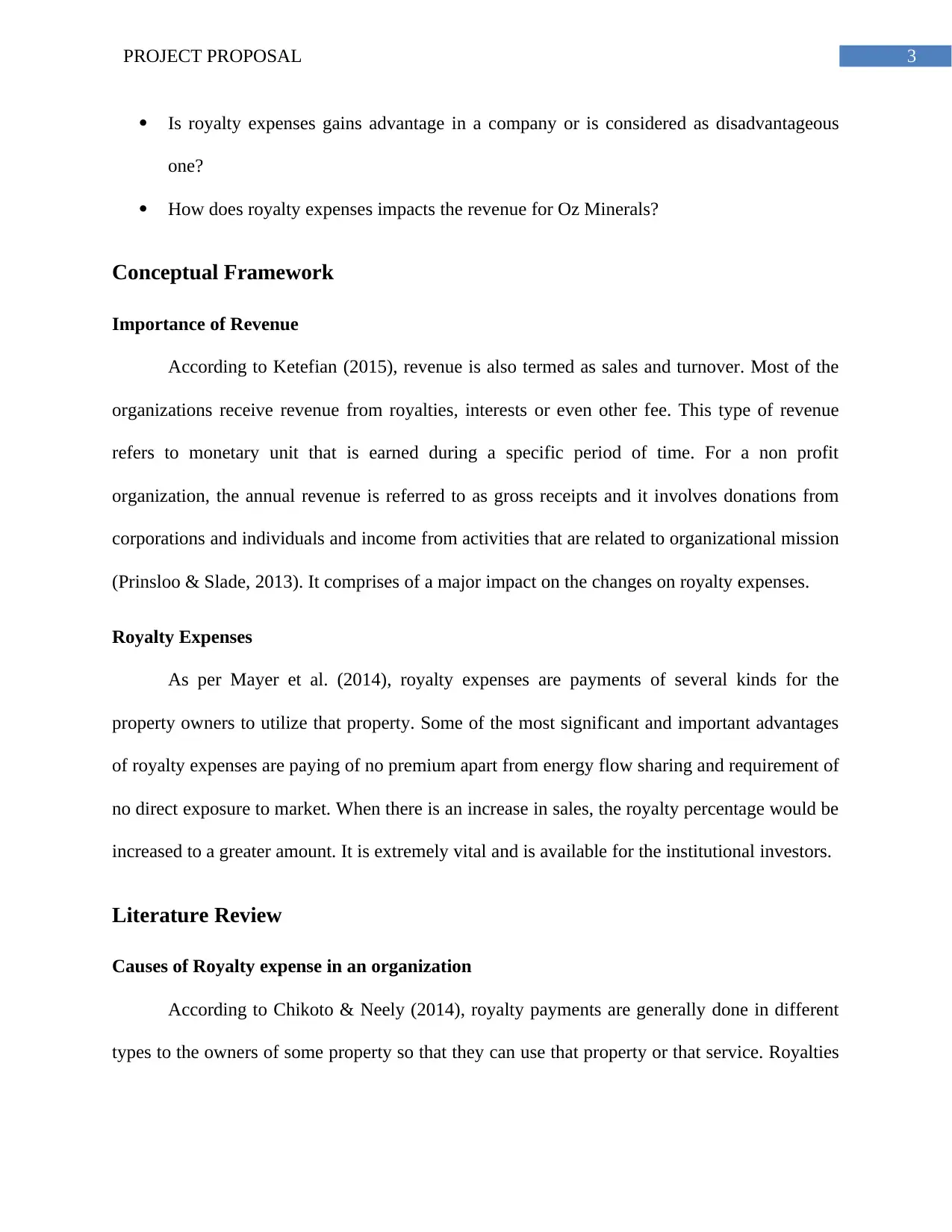
3PROJECT PROPOSAL
Is royalty expenses gains advantage in a company or is considered as disadvantageous
one?
How does royalty expenses impacts the revenue for Oz Minerals?
Conceptual Framework
Importance of Revenue
According to Ketefian (2015), revenue is also termed as sales and turnover. Most of the
organizations receive revenue from royalties, interests or even other fee. This type of revenue
refers to monetary unit that is earned during a specific period of time. For a non profit
organization, the annual revenue is referred to as gross receipts and it involves donations from
corporations and individuals and income from activities that are related to organizational mission
(Prinsloo & Slade, 2013). It comprises of a major impact on the changes on royalty expenses.
Royalty Expenses
As per Mayer et al. (2014), royalty expenses are payments of several kinds for the
property owners to utilize that property. Some of the most significant and important advantages
of royalty expenses are paying of no premium apart from energy flow sharing and requirement of
no direct exposure to market. When there is an increase in sales, the royalty percentage would be
increased to a greater amount. It is extremely vital and is available for the institutional investors.
Literature Review
Causes of Royalty expense in an organization
According to Chikoto & Neely (2014), royalty payments are generally done in different
types to the owners of some property so that they can use that property or that service. Royalties
Is royalty expenses gains advantage in a company or is considered as disadvantageous
one?
How does royalty expenses impacts the revenue for Oz Minerals?
Conceptual Framework
Importance of Revenue
According to Ketefian (2015), revenue is also termed as sales and turnover. Most of the
organizations receive revenue from royalties, interests or even other fee. This type of revenue
refers to monetary unit that is earned during a specific period of time. For a non profit
organization, the annual revenue is referred to as gross receipts and it involves donations from
corporations and individuals and income from activities that are related to organizational mission
(Prinsloo & Slade, 2013). It comprises of a major impact on the changes on royalty expenses.
Royalty Expenses
As per Mayer et al. (2014), royalty expenses are payments of several kinds for the
property owners to utilize that property. Some of the most significant and important advantages
of royalty expenses are paying of no premium apart from energy flow sharing and requirement of
no direct exposure to market. When there is an increase in sales, the royalty percentage would be
increased to a greater amount. It is extremely vital and is available for the institutional investors.
Literature Review
Causes of Royalty expense in an organization
According to Chikoto & Neely (2014), royalty payments are generally done in different
types to the owners of some property so that they can use that property or that service. Royalties
Paraphrase This Document
Need a fresh take? Get an instant paraphrase of this document with our AI Paraphraser
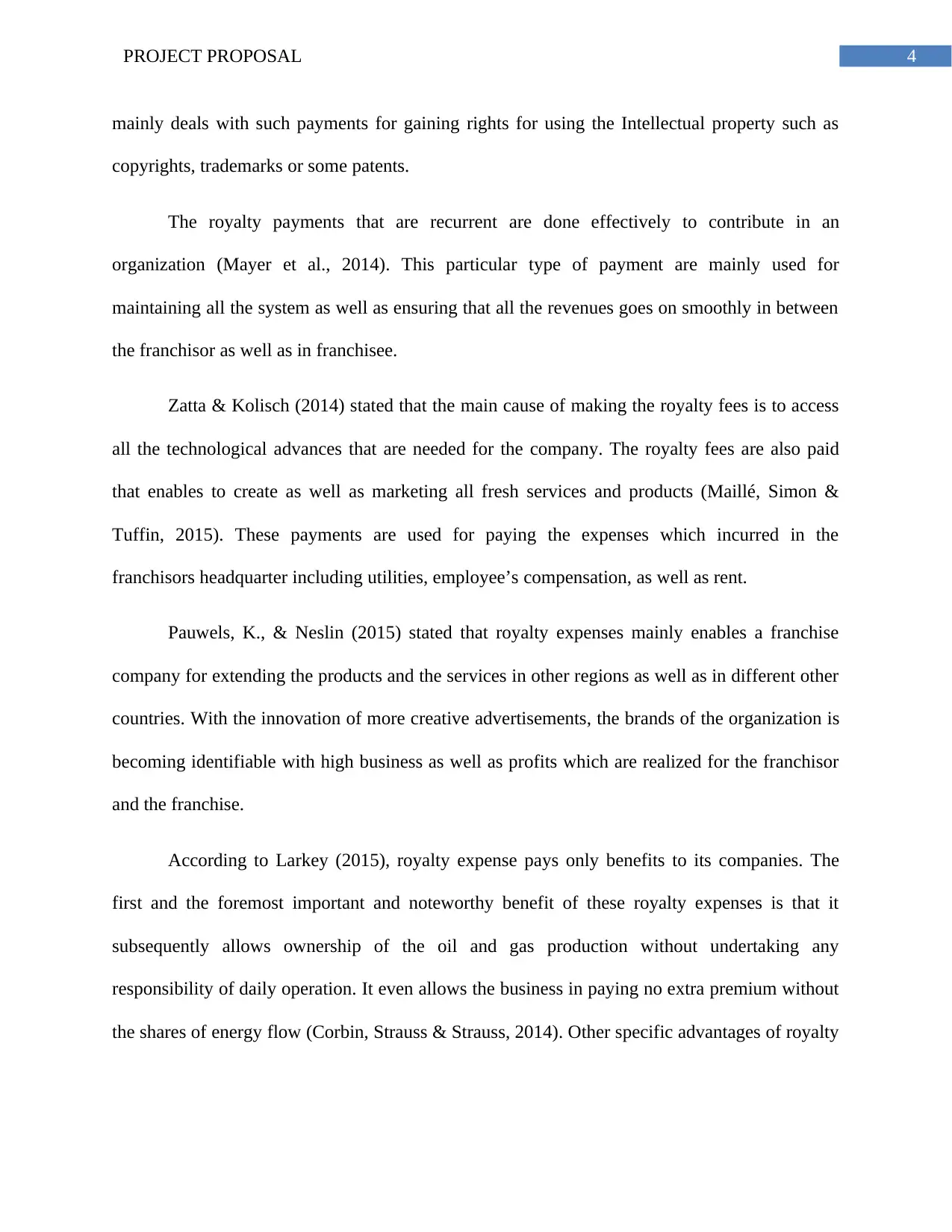
4PROJECT PROPOSAL
mainly deals with such payments for gaining rights for using the Intellectual property such as
copyrights, trademarks or some patents.
The royalty payments that are recurrent are done effectively to contribute in an
organization (Mayer et al., 2014). This particular type of payment are mainly used for
maintaining all the system as well as ensuring that all the revenues goes on smoothly in between
the franchisor as well as in franchisee.
Zatta & Kolisch (2014) stated that the main cause of making the royalty fees is to access
all the technological advances that are needed for the company. The royalty fees are also paid
that enables to create as well as marketing all fresh services and products (Maillé, Simon &
Tuffin, 2015). These payments are used for paying the expenses which incurred in the
franchisors headquarter including utilities, employee’s compensation, as well as rent.
Pauwels, K., & Neslin (2015) stated that royalty expenses mainly enables a franchise
company for extending the products and the services in other regions as well as in different other
countries. With the innovation of more creative advertisements, the brands of the organization is
becoming identifiable with high business as well as profits which are realized for the franchisor
and the franchise.
According to Larkey (2015), royalty expense pays only benefits to its companies. The
first and the foremost important and noteworthy benefit of these royalty expenses is that it
subsequently allows ownership of the oil and gas production without undertaking any
responsibility of daily operation. It even allows the business in paying no extra premium without
the shares of energy flow (Corbin, Strauss & Strauss, 2014). Other specific advantages of royalty
mainly deals with such payments for gaining rights for using the Intellectual property such as
copyrights, trademarks or some patents.
The royalty payments that are recurrent are done effectively to contribute in an
organization (Mayer et al., 2014). This particular type of payment are mainly used for
maintaining all the system as well as ensuring that all the revenues goes on smoothly in between
the franchisor as well as in franchisee.
Zatta & Kolisch (2014) stated that the main cause of making the royalty fees is to access
all the technological advances that are needed for the company. The royalty fees are also paid
that enables to create as well as marketing all fresh services and products (Maillé, Simon &
Tuffin, 2015). These payments are used for paying the expenses which incurred in the
franchisors headquarter including utilities, employee’s compensation, as well as rent.
Pauwels, K., & Neslin (2015) stated that royalty expenses mainly enables a franchise
company for extending the products and the services in other regions as well as in different other
countries. With the innovation of more creative advertisements, the brands of the organization is
becoming identifiable with high business as well as profits which are realized for the franchisor
and the franchise.
According to Larkey (2015), royalty expense pays only benefits to its companies. The
first and the foremost important and noteworthy benefit of these royalty expenses is that it
subsequently allows ownership of the oil and gas production without undertaking any
responsibility of daily operation. It even allows the business in paying no extra premium without
the shares of energy flow (Corbin, Strauss & Strauss, 2014). Other specific advantages of royalty
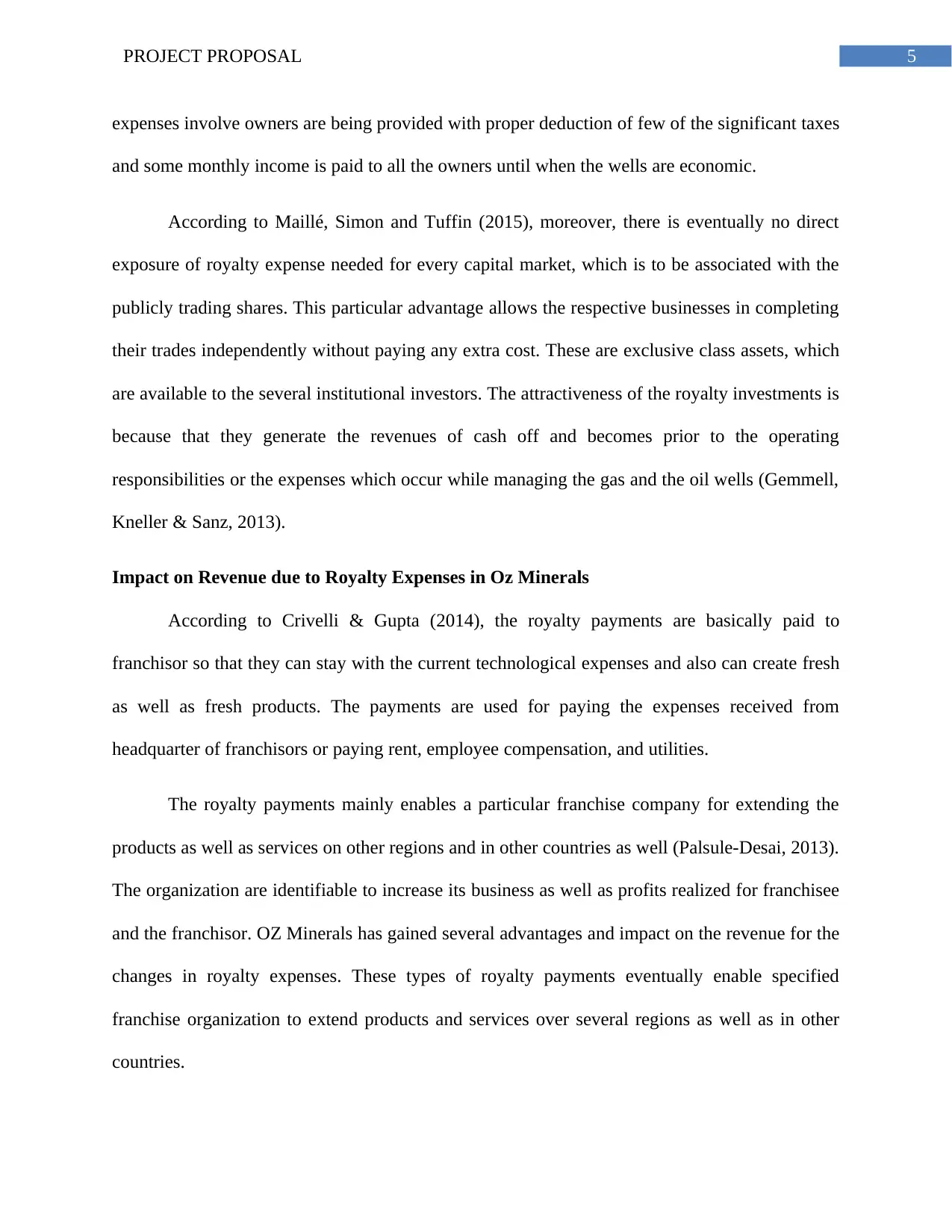
5PROJECT PROPOSAL
expenses involve owners are being provided with proper deduction of few of the significant taxes
and some monthly income is paid to all the owners until when the wells are economic.
According to Maillé, Simon and Tuffin (2015), moreover, there is eventually no direct
exposure of royalty expense needed for every capital market, which is to be associated with the
publicly trading shares. This particular advantage allows the respective businesses in completing
their trades independently without paying any extra cost. These are exclusive class assets, which
are available to the several institutional investors. The attractiveness of the royalty investments is
because that they generate the revenues of cash off and becomes prior to the operating
responsibilities or the expenses which occur while managing the gas and the oil wells (Gemmell,
Kneller & Sanz, 2013).
Impact on Revenue due to Royalty Expenses in Oz Minerals
According to Crivelli & Gupta (2014), the royalty payments are basically paid to
franchisor so that they can stay with the current technological expenses and also can create fresh
as well as fresh products. The payments are used for paying the expenses received from
headquarter of franchisors or paying rent, employee compensation, and utilities.
The royalty payments mainly enables a particular franchise company for extending the
products as well as services on other regions and in other countries as well (Palsule-Desai, 2013).
The organization are identifiable to increase its business as well as profits realized for franchisee
and the franchisor. OZ Minerals has gained several advantages and impact on the revenue for the
changes in royalty expenses. These types of royalty payments eventually enable specified
franchise organization to extend products and services over several regions as well as in other
countries.
expenses involve owners are being provided with proper deduction of few of the significant taxes
and some monthly income is paid to all the owners until when the wells are economic.
According to Maillé, Simon and Tuffin (2015), moreover, there is eventually no direct
exposure of royalty expense needed for every capital market, which is to be associated with the
publicly trading shares. This particular advantage allows the respective businesses in completing
their trades independently without paying any extra cost. These are exclusive class assets, which
are available to the several institutional investors. The attractiveness of the royalty investments is
because that they generate the revenues of cash off and becomes prior to the operating
responsibilities or the expenses which occur while managing the gas and the oil wells (Gemmell,
Kneller & Sanz, 2013).
Impact on Revenue due to Royalty Expenses in Oz Minerals
According to Crivelli & Gupta (2014), the royalty payments are basically paid to
franchisor so that they can stay with the current technological expenses and also can create fresh
as well as fresh products. The payments are used for paying the expenses received from
headquarter of franchisors or paying rent, employee compensation, and utilities.
The royalty payments mainly enables a particular franchise company for extending the
products as well as services on other regions and in other countries as well (Palsule-Desai, 2013).
The organization are identifiable to increase its business as well as profits realized for franchisee
and the franchisor. OZ Minerals has gained several advantages and impact on the revenue for the
changes in royalty expenses. These types of royalty payments eventually enable specified
franchise organization to extend products and services over several regions as well as in other
countries.
⊘ This is a preview!⊘
Do you want full access?
Subscribe today to unlock all pages.

Trusted by 1+ million students worldwide
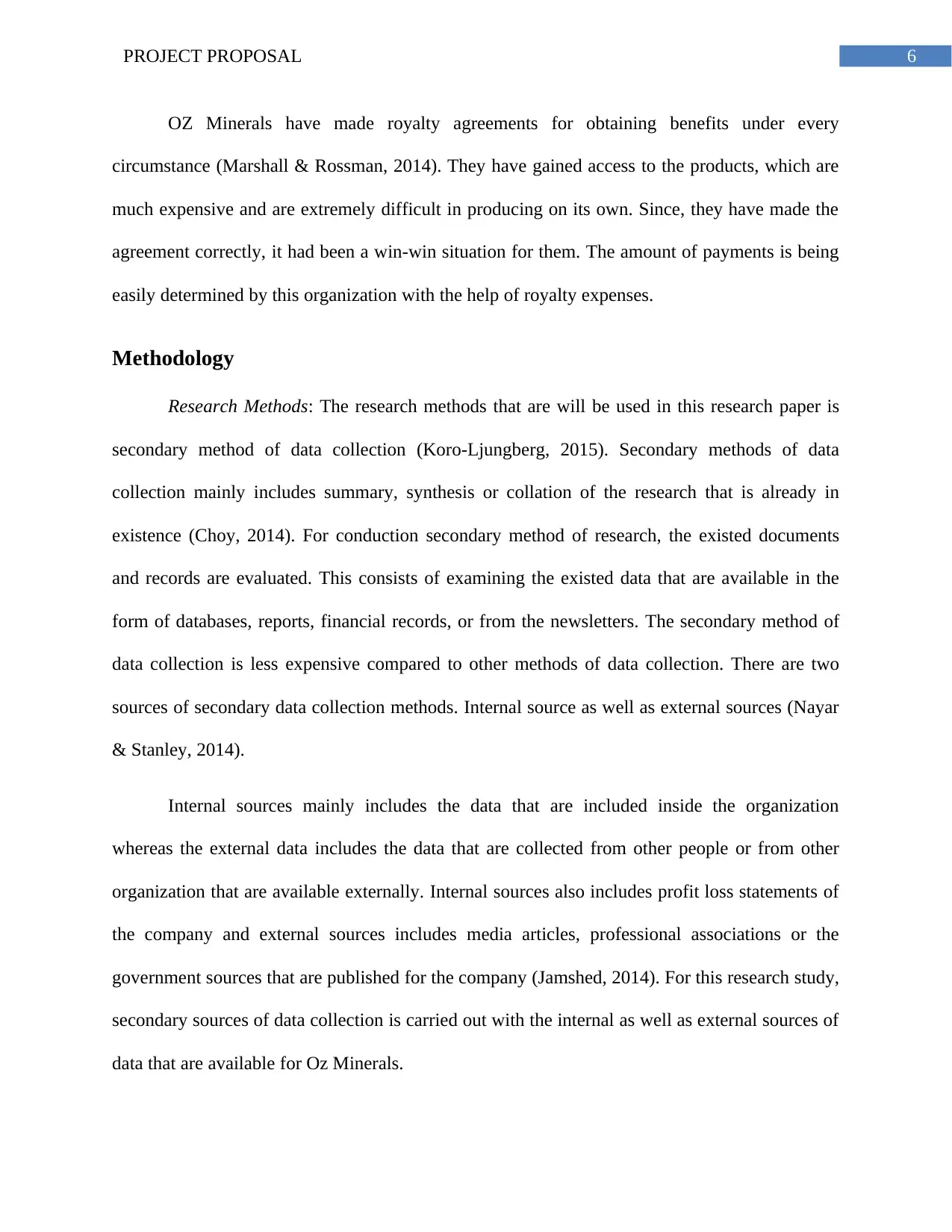
6PROJECT PROPOSAL
OZ Minerals have made royalty agreements for obtaining benefits under every
circumstance (Marshall & Rossman, 2014). They have gained access to the products, which are
much expensive and are extremely difficult in producing on its own. Since, they have made the
agreement correctly, it had been a win-win situation for them. The amount of payments is being
easily determined by this organization with the help of royalty expenses.
Methodology
Research Methods: The research methods that are will be used in this research paper is
secondary method of data collection (Koro-Ljungberg, 2015). Secondary methods of data
collection mainly includes summary, synthesis or collation of the research that is already in
existence (Choy, 2014). For conduction secondary method of research, the existed documents
and records are evaluated. This consists of examining the existed data that are available in the
form of databases, reports, financial records, or from the newsletters. The secondary method of
data collection is less expensive compared to other methods of data collection. There are two
sources of secondary data collection methods. Internal source as well as external sources (Nayar
& Stanley, 2014).
Internal sources mainly includes the data that are included inside the organization
whereas the external data includes the data that are collected from other people or from other
organization that are available externally. Internal sources also includes profit loss statements of
the company and external sources includes media articles, professional associations or the
government sources that are published for the company (Jamshed, 2014). For this research study,
secondary sources of data collection is carried out with the internal as well as external sources of
data that are available for Oz Minerals.
OZ Minerals have made royalty agreements for obtaining benefits under every
circumstance (Marshall & Rossman, 2014). They have gained access to the products, which are
much expensive and are extremely difficult in producing on its own. Since, they have made the
agreement correctly, it had been a win-win situation for them. The amount of payments is being
easily determined by this organization with the help of royalty expenses.
Methodology
Research Methods: The research methods that are will be used in this research paper is
secondary method of data collection (Koro-Ljungberg, 2015). Secondary methods of data
collection mainly includes summary, synthesis or collation of the research that is already in
existence (Choy, 2014). For conduction secondary method of research, the existed documents
and records are evaluated. This consists of examining the existed data that are available in the
form of databases, reports, financial records, or from the newsletters. The secondary method of
data collection is less expensive compared to other methods of data collection. There are two
sources of secondary data collection methods. Internal source as well as external sources (Nayar
& Stanley, 2014).
Internal sources mainly includes the data that are included inside the organization
whereas the external data includes the data that are collected from other people or from other
organization that are available externally. Internal sources also includes profit loss statements of
the company and external sources includes media articles, professional associations or the
government sources that are published for the company (Jamshed, 2014). For this research study,
secondary sources of data collection is carried out with the internal as well as external sources of
data that are available for Oz Minerals.
Paraphrase This Document
Need a fresh take? Get an instant paraphrase of this document with our AI Paraphraser
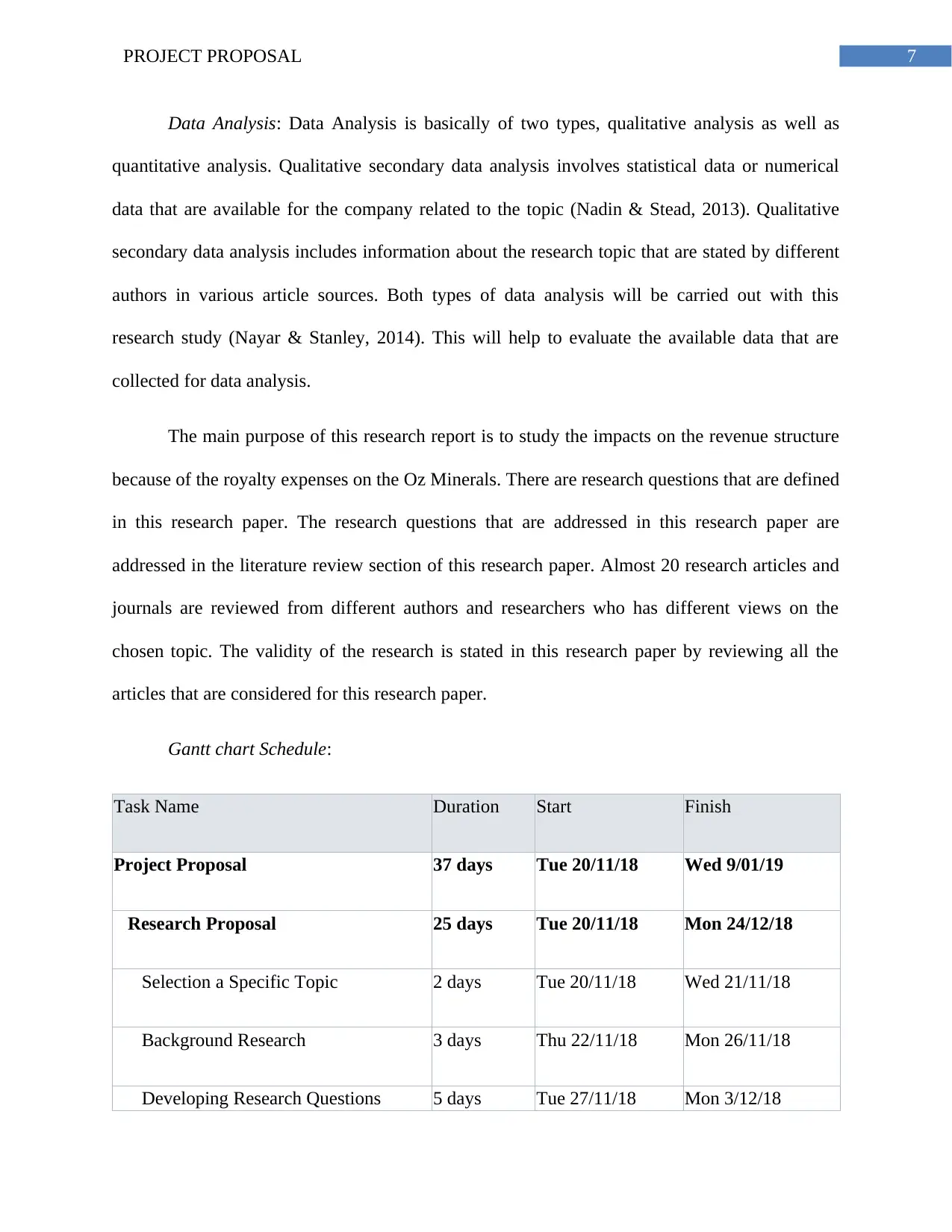
7PROJECT PROPOSAL
Data Analysis: Data Analysis is basically of two types, qualitative analysis as well as
quantitative analysis. Qualitative secondary data analysis involves statistical data or numerical
data that are available for the company related to the topic (Nadin & Stead, 2013). Qualitative
secondary data analysis includes information about the research topic that are stated by different
authors in various article sources. Both types of data analysis will be carried out with this
research study (Nayar & Stanley, 2014). This will help to evaluate the available data that are
collected for data analysis.
The main purpose of this research report is to study the impacts on the revenue structure
because of the royalty expenses on the Oz Minerals. There are research questions that are defined
in this research paper. The research questions that are addressed in this research paper are
addressed in the literature review section of this research paper. Almost 20 research articles and
journals are reviewed from different authors and researchers who has different views on the
chosen topic. The validity of the research is stated in this research paper by reviewing all the
articles that are considered for this research paper.
Gantt chart Schedule:
Task Name Duration Start Finish
Project Proposal 37 days Tue 20/11/18 Wed 9/01/19
Research Proposal 25 days Tue 20/11/18 Mon 24/12/18
Selection a Specific Topic 2 days Tue 20/11/18 Wed 21/11/18
Background Research 3 days Thu 22/11/18 Mon 26/11/18
Developing Research Questions 5 days Tue 27/11/18 Mon 3/12/18
Data Analysis: Data Analysis is basically of two types, qualitative analysis as well as
quantitative analysis. Qualitative secondary data analysis involves statistical data or numerical
data that are available for the company related to the topic (Nadin & Stead, 2013). Qualitative
secondary data analysis includes information about the research topic that are stated by different
authors in various article sources. Both types of data analysis will be carried out with this
research study (Nayar & Stanley, 2014). This will help to evaluate the available data that are
collected for data analysis.
The main purpose of this research report is to study the impacts on the revenue structure
because of the royalty expenses on the Oz Minerals. There are research questions that are defined
in this research paper. The research questions that are addressed in this research paper are
addressed in the literature review section of this research paper. Almost 20 research articles and
journals are reviewed from different authors and researchers who has different views on the
chosen topic. The validity of the research is stated in this research paper by reviewing all the
articles that are considered for this research paper.
Gantt chart Schedule:
Task Name Duration Start Finish
Project Proposal 37 days Tue 20/11/18 Wed 9/01/19
Research Proposal 25 days Tue 20/11/18 Mon 24/12/18
Selection a Specific Topic 2 days Tue 20/11/18 Wed 21/11/18
Background Research 3 days Thu 22/11/18 Mon 26/11/18
Developing Research Questions 5 days Tue 27/11/18 Mon 3/12/18
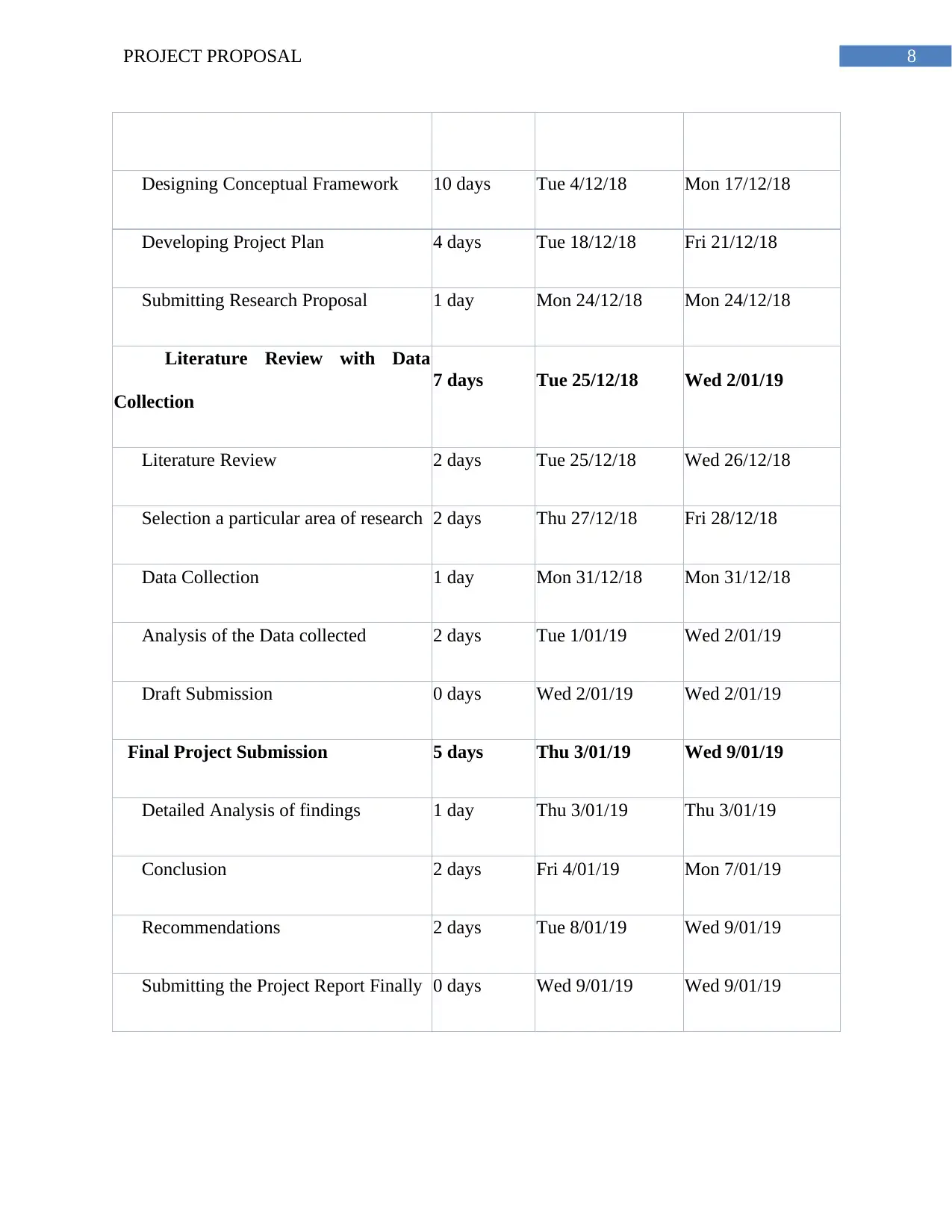
8PROJECT PROPOSAL
Designing Conceptual Framework 10 days Tue 4/12/18 Mon 17/12/18
Developing Project Plan 4 days Tue 18/12/18 Fri 21/12/18
Submitting Research Proposal 1 day Mon 24/12/18 Mon 24/12/18
Literature Review with Data
Collection
7 days Tue 25/12/18 Wed 2/01/19
Literature Review 2 days Tue 25/12/18 Wed 26/12/18
Selection a particular area of research 2 days Thu 27/12/18 Fri 28/12/18
Data Collection 1 day Mon 31/12/18 Mon 31/12/18
Analysis of the Data collected 2 days Tue 1/01/19 Wed 2/01/19
Draft Submission 0 days Wed 2/01/19 Wed 2/01/19
Final Project Submission 5 days Thu 3/01/19 Wed 9/01/19
Detailed Analysis of findings 1 day Thu 3/01/19 Thu 3/01/19
Conclusion 2 days Fri 4/01/19 Mon 7/01/19
Recommendations 2 days Tue 8/01/19 Wed 9/01/19
Submitting the Project Report Finally 0 days Wed 9/01/19 Wed 9/01/19
Designing Conceptual Framework 10 days Tue 4/12/18 Mon 17/12/18
Developing Project Plan 4 days Tue 18/12/18 Fri 21/12/18
Submitting Research Proposal 1 day Mon 24/12/18 Mon 24/12/18
Literature Review with Data
Collection
7 days Tue 25/12/18 Wed 2/01/19
Literature Review 2 days Tue 25/12/18 Wed 26/12/18
Selection a particular area of research 2 days Thu 27/12/18 Fri 28/12/18
Data Collection 1 day Mon 31/12/18 Mon 31/12/18
Analysis of the Data collected 2 days Tue 1/01/19 Wed 2/01/19
Draft Submission 0 days Wed 2/01/19 Wed 2/01/19
Final Project Submission 5 days Thu 3/01/19 Wed 9/01/19
Detailed Analysis of findings 1 day Thu 3/01/19 Thu 3/01/19
Conclusion 2 days Fri 4/01/19 Mon 7/01/19
Recommendations 2 days Tue 8/01/19 Wed 9/01/19
Submitting the Project Report Finally 0 days Wed 9/01/19 Wed 9/01/19
⊘ This is a preview!⊘
Do you want full access?
Subscribe today to unlock all pages.

Trusted by 1+ million students worldwide
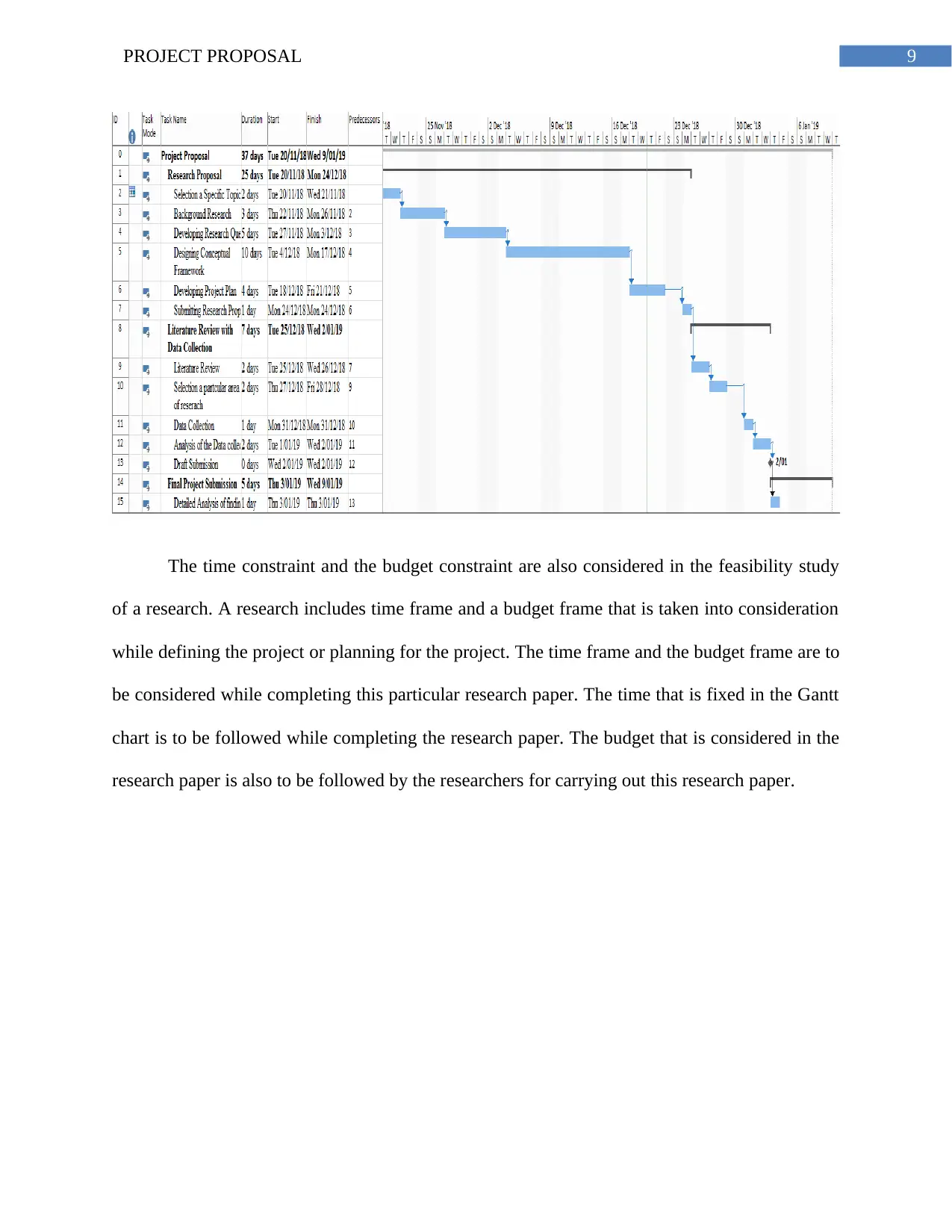
9PROJECT PROPOSAL
The time constraint and the budget constraint are also considered in the feasibility study
of a research. A research includes time frame and a budget frame that is taken into consideration
while defining the project or planning for the project. The time frame and the budget frame are to
be considered while completing this particular research paper. The time that is fixed in the Gantt
chart is to be followed while completing the research paper. The budget that is considered in the
research paper is also to be followed by the researchers for carrying out this research paper.
The time constraint and the budget constraint are also considered in the feasibility study
of a research. A research includes time frame and a budget frame that is taken into consideration
while defining the project or planning for the project. The time frame and the budget frame are to
be considered while completing this particular research paper. The time that is fixed in the Gantt
chart is to be followed while completing the research paper. The budget that is considered in the
research paper is also to be followed by the researchers for carrying out this research paper.
Paraphrase This Document
Need a fresh take? Get an instant paraphrase of this document with our AI Paraphraser
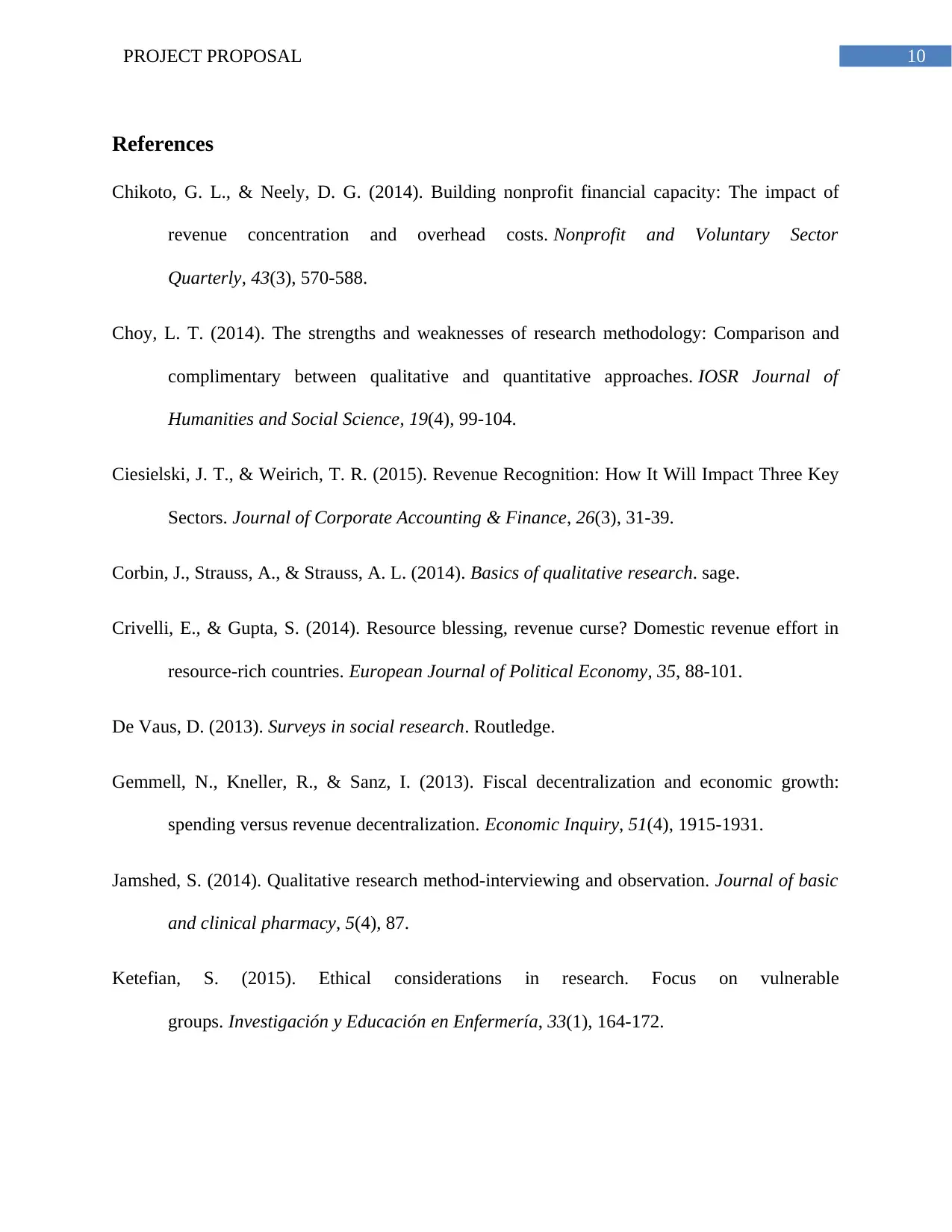
10PROJECT PROPOSAL
References
Chikoto, G. L., & Neely, D. G. (2014). Building nonprofit financial capacity: The impact of
revenue concentration and overhead costs. Nonprofit and Voluntary Sector
Quarterly, 43(3), 570-588.
Choy, L. T. (2014). The strengths and weaknesses of research methodology: Comparison and
complimentary between qualitative and quantitative approaches. IOSR Journal of
Humanities and Social Science, 19(4), 99-104.
Ciesielski, J. T., & Weirich, T. R. (2015). Revenue Recognition: How It Will Impact Three Key
Sectors. Journal of Corporate Accounting & Finance, 26(3), 31-39.
Corbin, J., Strauss, A., & Strauss, A. L. (2014). Basics of qualitative research. sage.
Crivelli, E., & Gupta, S. (2014). Resource blessing, revenue curse? Domestic revenue effort in
resource-rich countries. European Journal of Political Economy, 35, 88-101.
De Vaus, D. (2013). Surveys in social research. Routledge.
Gemmell, N., Kneller, R., & Sanz, I. (2013). Fiscal decentralization and economic growth:
spending versus revenue decentralization. Economic Inquiry, 51(4), 1915-1931.
Jamshed, S. (2014). Qualitative research method-interviewing and observation. Journal of basic
and clinical pharmacy, 5(4), 87.
Ketefian, S. (2015). Ethical considerations in research. Focus on vulnerable
groups. Investigación y Educación en Enfermería, 33(1), 164-172.
References
Chikoto, G. L., & Neely, D. G. (2014). Building nonprofit financial capacity: The impact of
revenue concentration and overhead costs. Nonprofit and Voluntary Sector
Quarterly, 43(3), 570-588.
Choy, L. T. (2014). The strengths and weaknesses of research methodology: Comparison and
complimentary between qualitative and quantitative approaches. IOSR Journal of
Humanities and Social Science, 19(4), 99-104.
Ciesielski, J. T., & Weirich, T. R. (2015). Revenue Recognition: How It Will Impact Three Key
Sectors. Journal of Corporate Accounting & Finance, 26(3), 31-39.
Corbin, J., Strauss, A., & Strauss, A. L. (2014). Basics of qualitative research. sage.
Crivelli, E., & Gupta, S. (2014). Resource blessing, revenue curse? Domestic revenue effort in
resource-rich countries. European Journal of Political Economy, 35, 88-101.
De Vaus, D. (2013). Surveys in social research. Routledge.
Gemmell, N., Kneller, R., & Sanz, I. (2013). Fiscal decentralization and economic growth:
spending versus revenue decentralization. Economic Inquiry, 51(4), 1915-1931.
Jamshed, S. (2014). Qualitative research method-interviewing and observation. Journal of basic
and clinical pharmacy, 5(4), 87.
Ketefian, S. (2015). Ethical considerations in research. Focus on vulnerable
groups. Investigación y Educación en Enfermería, 33(1), 164-172.
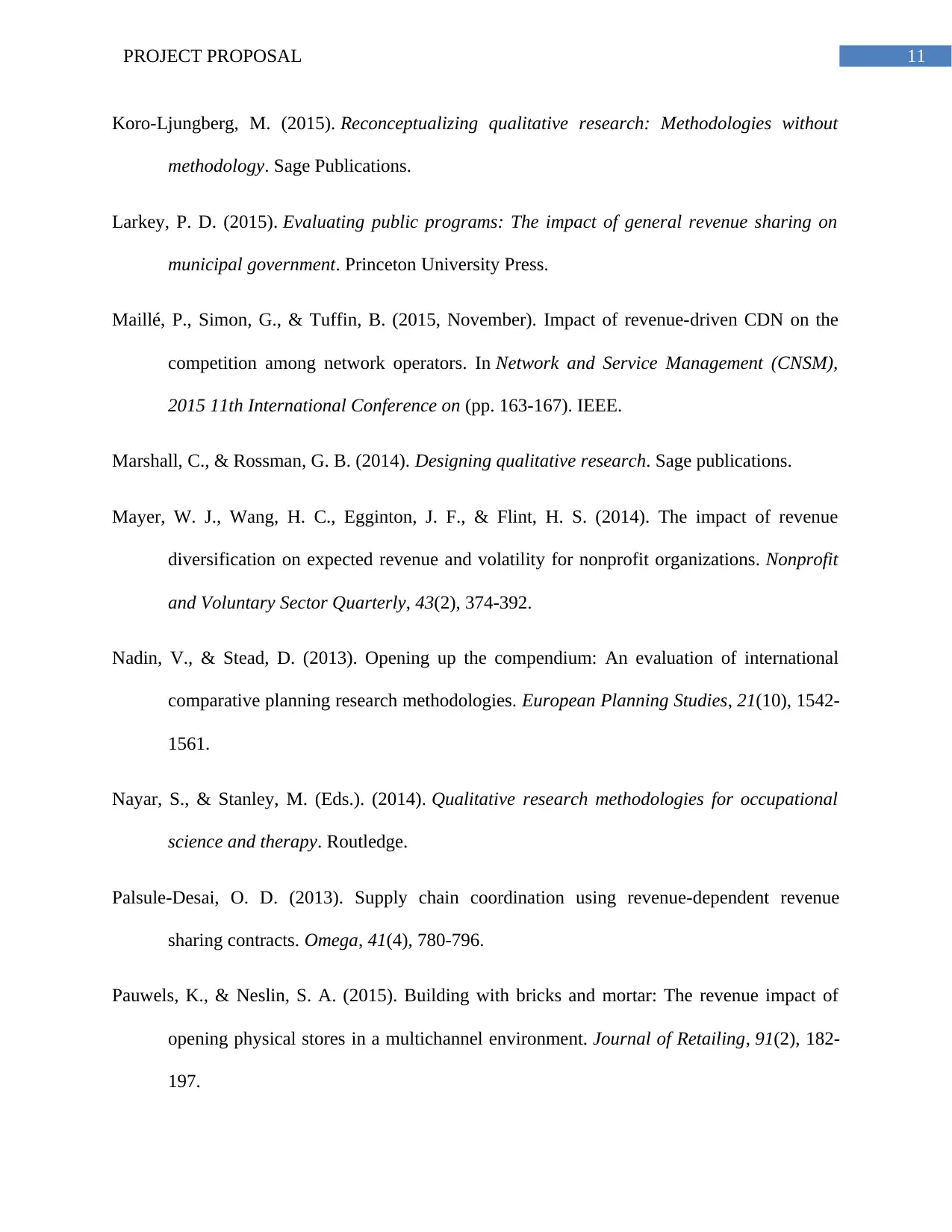
11PROJECT PROPOSAL
Koro-Ljungberg, M. (2015). Reconceptualizing qualitative research: Methodologies without
methodology. Sage Publications.
Larkey, P. D. (2015). Evaluating public programs: The impact of general revenue sharing on
municipal government. Princeton University Press.
Maillé, P., Simon, G., & Tuffin, B. (2015, November). Impact of revenue-driven CDN on the
competition among network operators. In Network and Service Management (CNSM),
2015 11th International Conference on (pp. 163-167). IEEE.
Marshall, C., & Rossman, G. B. (2014). Designing qualitative research. Sage publications.
Mayer, W. J., Wang, H. C., Egginton, J. F., & Flint, H. S. (2014). The impact of revenue
diversification on expected revenue and volatility for nonprofit organizations. Nonprofit
and Voluntary Sector Quarterly, 43(2), 374-392.
Nadin, V., & Stead, D. (2013). Opening up the compendium: An evaluation of international
comparative planning research methodologies. European Planning Studies, 21(10), 1542-
1561.
Nayar, S., & Stanley, M. (Eds.). (2014). Qualitative research methodologies for occupational
science and therapy. Routledge.
Palsule-Desai, O. D. (2013). Supply chain coordination using revenue-dependent revenue
sharing contracts. Omega, 41(4), 780-796.
Pauwels, K., & Neslin, S. A. (2015). Building with bricks and mortar: The revenue impact of
opening physical stores in a multichannel environment. Journal of Retailing, 91(2), 182-
197.
Koro-Ljungberg, M. (2015). Reconceptualizing qualitative research: Methodologies without
methodology. Sage Publications.
Larkey, P. D. (2015). Evaluating public programs: The impact of general revenue sharing on
municipal government. Princeton University Press.
Maillé, P., Simon, G., & Tuffin, B. (2015, November). Impact of revenue-driven CDN on the
competition among network operators. In Network and Service Management (CNSM),
2015 11th International Conference on (pp. 163-167). IEEE.
Marshall, C., & Rossman, G. B. (2014). Designing qualitative research. Sage publications.
Mayer, W. J., Wang, H. C., Egginton, J. F., & Flint, H. S. (2014). The impact of revenue
diversification on expected revenue and volatility for nonprofit organizations. Nonprofit
and Voluntary Sector Quarterly, 43(2), 374-392.
Nadin, V., & Stead, D. (2013). Opening up the compendium: An evaluation of international
comparative planning research methodologies. European Planning Studies, 21(10), 1542-
1561.
Nayar, S., & Stanley, M. (Eds.). (2014). Qualitative research methodologies for occupational
science and therapy. Routledge.
Palsule-Desai, O. D. (2013). Supply chain coordination using revenue-dependent revenue
sharing contracts. Omega, 41(4), 780-796.
Pauwels, K., & Neslin, S. A. (2015). Building with bricks and mortar: The revenue impact of
opening physical stores in a multichannel environment. Journal of Retailing, 91(2), 182-
197.
⊘ This is a preview!⊘
Do you want full access?
Subscribe today to unlock all pages.

Trusted by 1+ million students worldwide
1 out of 13
Related Documents
Your All-in-One AI-Powered Toolkit for Academic Success.
+13062052269
info@desklib.com
Available 24*7 on WhatsApp / Email
![[object Object]](/_next/static/media/star-bottom.7253800d.svg)
Unlock your academic potential
Copyright © 2020–2025 A2Z Services. All Rights Reserved. Developed and managed by ZUCOL.





